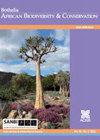南非荆棘(Rubus L.)的进化——来自分子标记的新见解
IF 0.5
4区 生物学
Q4 PLANT SCIENCES
引用次数: 0
摘要
背景:南非黑莓(Rubus L.,蔷薇科)是一个由6个本地种和至少12个引进类群组成的复杂类群,它们具有不同的倍性水平和不同的杂交倾向。杂交、基因渗入和无融合在持续进化中的作用已经根据形态学观察进行了假设,但迄今为止还没有进行严格的研究,也没有对该群体的系统发育进行研究。目的与方法:利用质体和核糖体DNA序列、核微卫星等3种分子标记揭示南非荆棘的进化模式和机制。结果:鉴定结果为四倍体thaumasius A.Beek和二倍体ludwigii Eckl。& Zeyh。作为独特的本地物种,而其他四个本地物种被证明是密切相关的,可能来自三个祖先。结论:古代杂交和区域间有限的基因流动(特别是冬季和夏季降雨区之间的基因流动)似乎是四倍体野生平纳图目前模式的主要驱动因素。和六倍体刚毛鼠。目前的杂交也有可能,尽管罕见。提出了“八倍体桥接”机制,克服了松鸡(或其他四倍体)与松鸡(R. pinnatus)之间的倍性繁殖障碍。在原生和外源分类群之间没有发现基因流动,但在柏树×尖尾树杂交种中发现了无性系重复,这表明原生和外源黑莓形成的同倍体杂交种可能发生无融合传播,可能存在新的入侵。另一方面,异倍体杂交种(R. bergii × rigidus)是反复形成的,仅以营养方式传播。本文章由计算机程序翻译,如有差异,请以英文原文为准。
Evolution of South African brambles (Rubus L.) – new insights from molecular markers
Background: South African brambles (Rubus L., Rosaceae) represent a complex group of six native species and at least 12 introduced taxa with different ploidy levels and varying tendencies to hybridisation. The role of hybridisation, introgression and apomixis in the ongoing evolution has been hypothesised based on morphological observations, but it has not been rigorously studied to date, and nor has the phylogeny of the group.
Objectives and methods: This paper aims to reveal the evolutionary patterns and mechanisms in South African brambles by employing three types of molecular markers: plastid and nuclear ribosomal DNA sequences, and nuclear microsatellites.
Results: The data confirmed the tetraploid R. thaumasius A.Beek and diploid R. ludwigii Eckl. & Zeyh. as distinct native species, while the other four native species are shown to be closely related and likely derived from three ancestors.
Conclusion: Ancient hybridisation and limited gene flow between regions (particularly between winter- and summer-rainfall zones) appear to be the main drivers of current patterns in the tetraploid R. pinnatus Willd. and hexaploid R. rigidus Sm. Current hybridisation is also likely, although rare. The mechanism of ‘octoploid bridge’ is proposed, which overcomes the ploidy reproduction barrier between R. pinnatus (or other tetraploids) and R. rigidus. No gene flow was detected between native and alien taxa, but clonal duplications were discovered in the R. bergii × pinnatus hybrid, which implies the possibility of apomictic spread of homoploid hybrids formed between native and introduced brambles and the potential for a new invasion. On the other hand, heteroploid hybrids (R. bergii × rigidus) are formed recurrently and spread only vegetatively.
求助全文
通过发布文献求助,成功后即可免费获取论文全文。
去求助
来源期刊

Bothalia
生物-植物科学
CiteScore
1.70
自引率
0.00%
发文量
12
期刊介绍:
Bothalia: African Biodiversity & Conservation is published by AOSIS for the South African National Biodiversity Institute (SANBI) and aims to disseminate knowledge, information and innovative approaches that promote and enhance the wise use and management of biodiversity in order to sustain the systems and species that support and benefit the people of Africa.
The journal was previously published as Bothalia, and had served the South African botanical community since 1921. However the expanded mandate of SANBI necessitated a broader scope for the journal, and in 2014, the subtitle, African Biodiversity & Conservation was added to reflect this change.
 求助内容:
求助内容: 应助结果提醒方式:
应助结果提醒方式:


